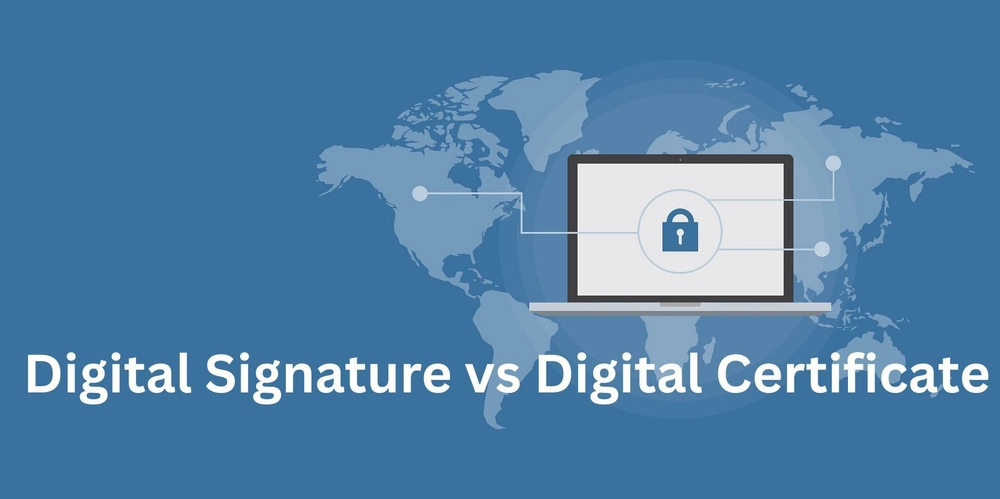Digital Signature vs Digital Certificate: Key Differences Explained
Sensitive information protection requires digital communication. Digital certificates and digital signatures are two crucial cybersecurity tools. But mostly users are not aware of their exact differences and how each one helps to secure online interactions. They both make important contributions to the security, integrity, and authenticity of digital transactions, digital signatures and digital certificates work for different purposes. This article will break down the key differences between a digital signature and digital certificate, highlight their individual roles, and explain how they work together in securing digital communications. What is a Digital Signature? Digital signatures, which are electronic copies of handwritten signatures or stamped seals, offer much more than identity verification. It offers a means of verifying the sender's identity and making sure the document or message hasn't been tampered with while in transit. Benefits of Digital Signatures Authentication Integrity Non-repudiation How Digital Signatures Work The message or document is hashed by the sender. A fixed-length string of characters that represents the message's contents is called a hash. The sender encrypts the hash with their private key to create the digital signature. Using the sender's public key, the recipient can decrypt the digital signature and compare the hash with the message's hash. If the two hashes match, the recipient can be sure that the message was sent by the sender and hasn't been tampered with. What is a Digital Certificate? An electronic document called a digital certificate is used to verify who owns a public key. Along with the public key itself, it also includes details about the key owner, including name and email address. A trustworthy third party, known as a Certificate Authority (CA), issues and validates the certificate. Benefits of Digital Certificates Identity verification Trust establishment Encryption How Digital Certificates Work The certificate has several components: Public Key - To encrypt the messages or verify digital signatures Certificate Authority (CA) - A valid third party that confirms the key owner's identity Validity Period - Range of dates that the certificate is valid. Digital Signature of the CA - The certificate's authenticity and lack of tampering are confirmed by the CA's digital signature. Differences Between Digital Signatures and Digital Certificates They play important roles in securing digital communication, they have different purposes and function differently: The main purposes of a digital signature are to verify the integrity of a message or document and to verify who sent it. But in digital certificate serves as proof of ownership for a public key. Because it guarantees that the recipient can trust the public key supplied by the sender, it is a component of the public key infrastructure (PKI), which makes secure communications possible. Digital signature is used to verify the authenticity of documents, emails, and messages. But in digital certificate are mostly utilized for data encryption and online identity verification. Digital signatures themselves don't depend on a CA, even though certificate authorities might occasionally be involved in the signing process (for example, by timestamping or signing certificates). Digital certificates are intrinsically linked to certificate authorities. To create trust, a certified public accountant issues and signs the certificate. To involve creating a unique signature for a particular document using asymmetric cryptography (private and public keys). In digital certificate confirms the legitimacy of the public key and is connected to the certificate that has been issued by a reliable CA. Relationship Between Digital Signatures and Digital Certificates Although they have different functions, digital certificates and digital signatures are frequently combined in secure communication. When someone signs a document using a digital signature, for instance, the digital certificate can be used to confirm the signer's identity and build confidence in the signature. In the absence of the certificate, the recipient would be unable to confirm that the public key used to generate the signature actually belongs to the sender. Digital certificates serve as the basis for digital signatures, guaranteeing that the sender's identity and the message's authenticity are appropriately verified. When to Use a Digital Signature vs a Digital Certificate Use a Digital Signature When a document or message's sender needs to be verified. When maintaining a message's or document's integrity is important. When you want to make sure the sender can't deny sending the message Use a Digital Certificate: When a public key's authenticity needs to be confirmed When establishing trust between parties, in digital comm

Sensitive information protection requires digital communication. Digital certificates and digital signatures are two crucial cybersecurity tools. But mostly users are not aware of their exact differences and how each one helps to secure online interactions.
They both make important contributions to the security, integrity, and authenticity of digital transactions, digital signatures and digital certificates work for different purposes. This article will break down the key differences between a digital signature and digital certificate, highlight their individual roles, and explain how they work together in securing digital communications.
What is a Digital Signature?
Digital signatures, which are electronic copies of handwritten signatures or stamped seals, offer much more than identity verification. It offers a means of verifying the sender's identity and making sure the document or message hasn't been tampered with while in transit.
Benefits of Digital Signatures
- Authentication
- Integrity
- Non-repudiation
How Digital Signatures Work
- The message or document is hashed by the sender. A fixed-length string of characters that represents the message's contents is called a hash.
- The sender encrypts the hash with their private key to create the digital signature.
- Using the sender's public key, the recipient can decrypt the digital signature and compare the hash with the message's hash.
- If the two hashes match, the recipient can be sure that the message was sent by the sender and hasn't been tampered with.
What is a Digital Certificate?
An electronic document called a digital certificate is used to verify who owns a public key. Along with the public key itself, it also includes details about the key owner, including name and email address. A trustworthy third party, known as a Certificate Authority (CA), issues and validates the certificate.
Benefits of Digital Certificates
- Identity verification
- Trust establishment
- Encryption
How Digital Certificates Work
The certificate has several components:
Public Key - To encrypt the messages or verify digital signatures
Certificate Authority (CA) - A valid third party that confirms the key owner's identity
Validity Period - Range of dates that the certificate is valid.
Digital Signature of the CA - The certificate's authenticity and lack of tampering are confirmed by the CA's digital signature.
Differences Between Digital Signatures and Digital Certificates
They play important roles in securing digital communication, they have different purposes and function differently:
The main purposes of a digital signature are to verify the integrity of a message or document and to verify who sent it. But in digital certificate serves as proof of ownership for a public key. Because it guarantees that the recipient can trust the public key supplied by the sender, it is a component of the public key infrastructure (PKI), which makes secure communications possible.
Digital signature is used to verify the authenticity of documents, emails, and messages. But in digital certificate are mostly utilized for data encryption and online identity verification.
Digital signatures themselves don't depend on a CA, even though certificate authorities might occasionally be involved in the signing process (for example, by timestamping or signing certificates). Digital certificates are intrinsically linked to certificate authorities. To create trust, a certified public accountant issues and signs the certificate.
To involve creating a unique signature for a particular document using asymmetric cryptography (private and public keys). In digital certificate confirms the legitimacy of the public key and is connected to the certificate that has been issued by a reliable CA.
Relationship Between Digital Signatures and Digital Certificates
Although they have different functions, digital certificates and digital signatures are frequently combined in secure communication. When someone signs a document using a digital signature, for instance, the digital certificate can be used to confirm the signer's identity and build confidence in the signature. In the absence of the certificate, the recipient would be unable to confirm that the public key used to generate the signature actually belongs to the sender.
Digital certificates serve as the basis for digital signatures, guaranteeing that the sender's identity and the message's authenticity are appropriately verified.
When to Use a Digital Signature vs a Digital Certificate
Use a Digital Signature
- When a document or message's sender needs to be verified.
- When maintaining a message's or document's integrity is important.
- When you want to make sure the sender can't deny sending the message
Use a Digital Certificate:
- When a public key's authenticity needs to be confirmed
- When establishing trust between parties, in digital communication is necessary.
- Online communications must be secure when utilizing SSL/TLS to authenticate software, encrypt emails, or browse websites.
Conclusion
They are both important for protecting online communications, but they are two different tools with different purposes and uses. It verifies the identity of the entity behind a public key. However, a digital signature ensures that the document or message is authentic and unchangeable. Together, they serve as the cornerstone of many modern security systems, ensuring the dependability and confidentiality of digital communications.
The differences and relationships between these two technologies will help individuals and businesses select the best tools for different security purposes. They work together to protect the authenticity, integrity, and confidentiality of digital data.
You can also, refer to this article Digital Signature vs. Digital Certificate for more detailed information.




















_Muhammad_R._Fakhrurrozi_Alamy.jpg?width=1280&auto=webp&quality=80&disable=upscale#)
















































